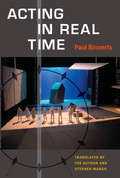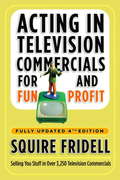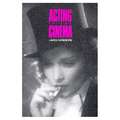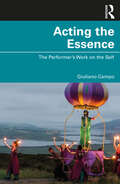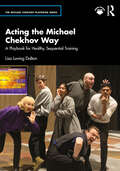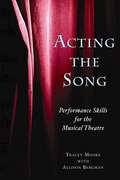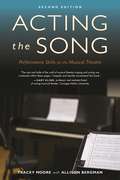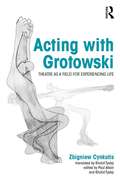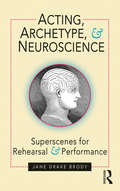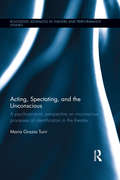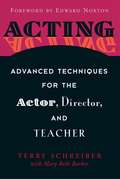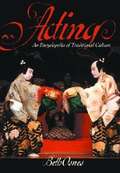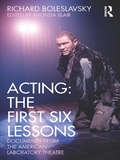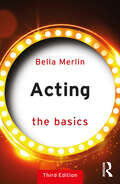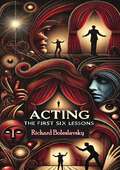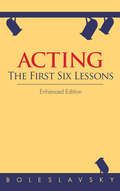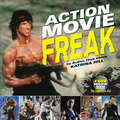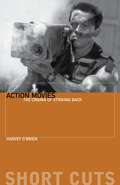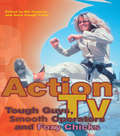- Table View
- List View
Acting in Musical Theatre: A Comprehensive Course
by Joe Deer Rocco Dal VeraActing in Musical Theatre remains the only complete course in approaching a role in a musical. It covers fundamental skills for novice actors, practical insights for professionals, and even tips to help veteran musical performers refine their craft. Updates in this expanded and revised second edition include: A brand new companion website for students and teachers, including Powerpoint lecture slides, sample syllabi, and checklists for projects and exercises. Learning outcomes for each chapter to guide teachers and students through the book’s core ideas and lessons New style overviews for pop and jukebox musicals Extensive updated professional insights from field testing with students, young professionals, and industry showcases Full-colour production images, bringing each chapter to life Acting in Musical Theatre’s chapters divide into easy-to-reference units, each containing group and solo exercises, making it the definitive textbook for students and practitioners alike.
Acting in Real Time
by Paul BinnertsActing in Real Time by renowned Dutch director and acting teacher Paul Binnerts describes his method for Real-Time Theater, which authorizes actors to actively determine how a story is told---they are no longer mere vehicles for delivering the playwright's message or the director's interpretations of the text. This level of involvement allows actors to deepen their grasp of the material and amplify their stage presence, resulting in more engaged and nuanced performances. The method offers a postmodern challenge to Stanislavski and Brecht, whose theories of stage realism dominated the twentieth century. In providing a new way to consider the actor's presence on stage, Binnerts advocates breaking down the "fourth wall" that separates audiences and actors and has been a central tenet of acting theories associated with realism. In real-time theater, actors forgo attempts to become characters and instead understand their function to be storytellers who are fully present on stage and may engage the audience and their fellow actors directly. Paul Binnerts analyzes the ascendance of realism as the dominant theater and acting convention and how its methods can hinder the creation of a more original, imaginative theater. His description of the techniques of real-time theater is illuminated by practical examples from his long experience in the stage. The book then offers innovative exercises that provide training in the real-time technique, including physical exercises that help the actor become truly present in performance. Acting in Real Time also includes a broad overview of the history of acting and realism's relationship to the history of theater architecture, offering real-time theater as an alternative. The book will appeal to actors and acting students, directors, stage designers, costume designers, lighting designers, theater historians, and dramaturgs.
Acting in Television Commercials for Fun and Profit: Fully Updated 4th Edition
by Squire FridellThe Ultimate Guide to Commercial Success Acting in television commercials is a highly competitive business, but it can also be very lucrative. Whether you’re looking for your first break or want to take your acting career to the next level, Squire Fridell will give you the insider’s edge. Arguably the king of TV commercials, Fridell distills four decades of experience in this comprehensive, humorously written guide that has been indispensable to aspiring TV commercial actors since the first edition hit the shelves in 1980. This fully updated fourth edition gives the lowdown on how online and digital technologies have changed the industry and tells you everything you need to know about: • Getting a terrific headshot • Writing a winning résumé • Finding (and keeping) the perfect agent • Honing the skills that every serious commercial actor should have • Auditioning well and getting the job • Using the best online services for posting your headshot, résumé, and reel You’ll learn how to launch your commercial acting career and–more important–how to sustain it and be successful.
Acting in the Academy: The History of Professional Actor Training in US Higher Education
by Peter ZazzaliThere are over 150 BFA and MFA acting programs in the US today, nearly all of which claim to prepare students for theatre careers. Peter Zazzali contends that the curricula of these courses represent an ethos that is as outdated as it is limited, given today’s shrinking job market for stage actors. Acting in the Academy traces the history of actor training in universities to make the case for a move beyond standard courses in voice and speech, movement, or performance, to develop an entrepreneurial model that motivates and encourages students to create their own employment opportunities. This book answers questions such as: How has the League of Professional Theatre Training Programs shaped actor training in the US? How have training programmes and the acting profession developed in relation to one another? What impact have these developments had on American acting as an art form? Acting in the Academy calls for a reconceptualization of actor training the US, and looks to newly empower students of performance with a fresh, original perspective on their professional development.
Acting in the Cinema
by James NaremoreJames Naremore focuses on the work of film acting, showing what players contribute to movies. Ranging from the earliest short subjects of Charles Chaplin to the contemporary features of Robert DeNiro, he develops a useful means of analyzing performance in the age of mechanical reproduction.
Acting the Essence: The Performer's Work on the Self
by Giuliano CampoActing the Essence examines the theory, practice, and history of the art of the performer from the perspective of its inner nature as work on oneself, within, around, and beyond the pedagogy of the actor. Ref lecting primarily on the legacy of Jerzy Grotowski, this book is composed of a series of ref lections on the Stanislavskian lineage of practitioners and related authors, in an attempt to revive awareness of the original path traced by the Russian master and to refine certain ambiguities in contemporary training. In a new media age of image and sound, accompanied by a proliferation of new technologies and means to communicate, emphasised by the COVID-19 crisis, a classic question comes to be asked of us again: What is the essence and the principal objective of the work of the performer? Is performing art still necessary? While proposing a theoretical advancement of the discipline and an historical overview of the relevant practices, this book provides tools for a better understanding of the traditional function of the performer’s practice as work on the self, for its ecological renaissance through a conscient use of trance, attention, and altered states of consciousness. This book offers insight for students in drama, theatre, and performance courses studying acting and performance at university.
Acting the Michael Chekhov Way: A Playbook for Healthy, Sequential Training (The Michael Chekhov Playbook Series)
by Lisa Loving DaltonRooted in Chekhov’s Guiding Principles and Laws of Composition, Acting the Michael Chekhov Way: A Playbook for Healthy, Sequential Training offers a step-by-step pathway for actors, directors, and teachers with an emphasis on the health and wellbeing of the performer.Developed over 30 years within the National Michael Chekhov Association’s renowned certification training, this clear, accessible training sequence for Michael Chekhov’s techniques is designed to support artists at every level. The chapters build logically and functionally, layering in benefits for artistic and personal growth. Central to the approach is the Chart of Inspired Action, created by Chekhov for his student and estate executrix, Mala Powers, who co-founded this pedagogy with Dalton and Professor Wil Kilroy. In these pages, Dalton introduces SynthAnalysis™, a groundbreaking synthesis of Stanislavsky’s analysis and Chekhov’s methods, bridging theory and practice tested through decades of global application. She also shares anecdotal insights from her 45-year acting/stunt career and draws on Chekhov’s esoteric inspirations—elements often absent in most books and teachings on Chekhov. The book presents mystical concepts like the goblet in playful, functional ways, empowering artists to use them as imaginative metaphors and explore their deeper potential.A helpful tool for both solo and classroom use, Acting the Michael Chekhov Way will speak directly to the actor and their teachers, guiding them on a transformative journey into the heart of inspired action and creative freedom.The book includes access to detailed discussions, additional activities, downloadable templates, and suggested syllabi and tips for instructors, available at www.resourcecentre.routledge.com/books/9781032844480.
Acting the Part
by Z.R. EllorThis delightfully tropey teen romance perfect for fans of Ashley Poston and Lyla Lee follows a queer teen actor navigating their gender identity—while pretending to date their co-star. Queer actor Lily Ashton has found fame playing lesbian warrior Morgantha on the hit TV show Galaxy Spark. Lily knows how little representation queer girls have, so when the showrunners reveal that Morgantha’s on-screen love interest, Alietta, is going to be killed off, Lily orchestrates an elaborate fake-dating scheme with the standoffish actress who plays her, to generate press and ensure a happy ending for the #Morganetta ship.But while playing a doting girlfriend on- and off-screen, Lily struggles with whether a word like “girl” applies to them at all.Lily’s always been good at playing a part. But are they ready to share their real self, even if it means throwing everything they’ve fought for away?
Acting the Song: Performance Skills for the Musical Theatre
by Tracey Moore Allison BergmanActing the Song offers a contemporary, integrated approach to singing in musicals that results in better-trained, smarter performers who can use song to add drama and dimension to their roles. Directors, teachers of musical theater, and students--including actors, singers, or dancers--will find time-tested advice, exercises and worksheets for all skill levels. This book guides readers through musical theater elements, classroom workshops, and the world of professional auditions and performances. Chapters cover vocal and physical warm-ups, body movement, finding subtext, creating a character, song structure, interpreting text of music and lyrics, risks and spontaneity, memorization, collaboration, keeping a performance fresh, and much more. Both teachers and students will appreciate the sections for beginning, intermediate, and advanced performers. Everyone involved in musical theater, from new students to working professionals, will benefit from this rich resource.
Acting the Song: Performance Skills for the Musical Theatre
by Tracey Moore Allison BergmanActing the Song offers a contemporary, integrated approach to singing in musicals that results in better-trained, smarter performers everyone wants to work with. In this new, thoroughly updated edition of the paperback, directors and teachers of musical theater will find guidance in developing and leading musical theater elements, classroom workshops, and the world of professional auditions and performances. A companion ebook specifically for students-including actors, singers, or dancers-contains time-tested advice, exercises, and worksheets for all skill levels, with links to additional resources online. Subjects for both versions cover:Singing and acting terminologyUse of microphones, recording devices, and other technologyVocal and physical warm-ups, movements, and gesturesCreating a characterFinding subtext, interpreting music and lyrics, and song structureCollaborating with other actorsKeeping a performance fresh and newUsing social media and online audition sitesTeachers and students alike will appreciate the sections for beginning, intermediate, and advanced performers. Covering all changes to the industry, education, music styles, and audition protocols, everyone involved in musical theater, from new students to working professionals, will benefit from this rich resource.Allworth Press, an imprint of Skyhorse Publishing, publishes a broad range of books on the visual and performing arts, with emphasis on the business of art. Our titles cover subjects such as graphic design, theater, branding, fine art, photography, interior design, writing, acting, film, how to start careers, business and legal forms, business practices, and more. While we don't aspire to publish a New York Times bestseller or a national bestseller, we are deeply committed to quality books that help creative professionals succeed and thrive. We often publish in areas overlooked by other publishers and welcome the author whose expertise can help our audience of readers.
Acting with Grotowski: Theatre as a Field for Experiencing Life
by Zbigniew Cynkutis‘Zbigniew Cynkutis’ writings constitute invaluable testimony of his work with Jerzy Grotowski during the ‘theatre of productions’ phase and beyond. Cynkutis’ insights elucidate aspects of the Laboratory Theatre’s praxis and provide a unique perspective on the questions most often asked about Grotowski. Authored by one of the Laboratory Theatre’s most accomplished actors, this book draws on long-term theatre research and deep knowledge of the craft of acting to offer practical advice indispensable to the professional and aspiring actor alike. The volume offers the English-speaking reader an unprecedented richness of primary source material, which sheds new light on the practical work of one of the most influential theatre directors of the 20th century. Cynkutis’ voice is sincere and direct, and will continue to inspire new generations of theatre practitioners.’ – Dominika Laster, Yale University Acting with Grotowski: Theatre as a Field for Experiencing Life explores the actor-director dynamic through the experience of Zbigniew Cynkutis, one of Polish director Jerzy Grotowski’s foremost collaborators. Cynkutis’s work as an actor, combined with his later work as a director and theatre manager, gave him a visionary overview based on precise embodied understanding. Cynkutis’s writings yield numerous insights into the commitment needed to make innovative, challenging theatre. A central component of Acting with Grotowski is his distinctive approach to training: ‘Conversations with the Body’ includes a range of techniques and approaches to warming up, rehearsing and creating work from a physical starting point, beautifully illustrated by Bill Ireland. The book comprises reflections and practical suggestions on a range of subjects – theatre and culture, improvisation, ethics, group dynamics, and Cynkutis’s vision for the Wrocław Second Studio. It contains visual and textual materials from Cynkutis’s own private archive, such as diary entries and letters. Acting with Grotowski demonstrates the thin line that separates life and art when an artist works with extreme commitment in testing political and social conditions.
Acting, Archetype, and Neuroscience: Superscenes for Rehearsal and Performance
by Jane Drake Brody"How do we move actors into the less accessible regions of themselves and release hotter, more dangerous, and less literal means of approaching a role?" Superscenes are a revolutionary new mode of teaching and rehearsal, allowing the actor to discover and utilize the primal energies underlying dramatic texts. In Acting, Archetype, and Neuroscience Jane Drake Brody draws upon a lifetime’s experience in the theatre, alongside the best insights into pedagogical practice in the field, the work of philosophers and writers who have focused on myth and archetype, and the latest insights of neuroscience. The resulting interdisciplinary, exciting volume works to: Mine the essentials of accepted acting theory while finding ways to access more primally-based human behavior in actors Restore a focus on storytelling that has been lost in the rush to create complex characters with arresting physical and vocal lives Uncover the mythical bones buried within every piece of dramatic writing; the skeletal framework upon which hangs the language and drama of the play itself Focus on the actor’s body as the only place where the conflict inherent in drama can be animated. Acting, Archetype, and Neuroscience weaves together a wealth of seemingly disparate performance methods, exciting actors to imaginatively and playfully take risks they might otherwise avoid. A radical new mixture of theory and practice by a highly respected teacher of acting, this volume is a must-read for students and performance practitioners alike.
Acting, Spectating and the Unconscious: A psychoanalytic perspective on unconscious mechanisms of identification in spectating and acting in the theatre. (Routledge Advances in Theatre & Performance Studies)
by Maria Grazia TurriFrom Aristotle’s theory of tragic katharsis onwards, theorists of the theatre have long engaged with the question of what spectatorship entails. This question has, directly or indirectly, often been extended to the investigation of acting. Acting, Spectating, and the Unconscious approaches the unconscious aspects of spectatorship and acting afresh. Interweaving psychoanalytic descriptions of processes such as transference, unconscious phantasy, and alpha-function with an in-depth survey of theories of spectating and acting from thinkers such as Brecht, Diderot, Rousseau and Plato, Maria Grazia Turri offers a significant insight into the emotions inherent in both the art of the actor, and the spectator’s experience. A compelling investigation of the unconscious communication between spectators and actors, this volume is a must-read for students and scholars fascinated by theatre spectatorship.
Acting: Advanced Techniques for the Actor, Director, and Teacher
by Edward Norton Terry Schreiber Mary Beth BarberHoned by the author's 35 years of teaching, this advanced book offers different warm-up exercises concentrating on the actor's sense of smell, sound, sight, and touch; sensory tools for conveying the climate and environment of the text; tips for suggesting a character's physical conditions; and much more. Individual exercises will help actors to free the voice and body, create a character, find the action and condition of scenes, and explore the subconscious for effective emotional recall. Readers will also find meticulous guidelines for best using rehearsal time and preparing for in-class scene work. The foreword is written by two-time Academy Award nominee Edward Norton. Those who act, direct, or teach will not want to miss the acting lessons that have made T. Schreiber Studio a premier actor training program.
Acting: An International Encyclopedia
by Beth OsnesExpanding beyond the conventional western concept of theater, the reference explores current and historical rituals, festivals, and performances from countries and cultures around the world; contributions of women to acting and the performing arts; and cinema and the film industry. The cross-referencing is extensive, and entry-specific references augment the general bibliography.
Acting: Documents from the American Laboratory Theatre
by Richard Boleslavsky Rhonda BlairActing: The First Six Lessons was first published in 1933 and remains a key text for anyone studying acting today. These dramatic dialogues between teacher and idealistic student explore the field of acting according to one of the original teachers of Stanislavsky’s System in America. <p><p> This new edition of an essential text is edited by Rhonda Blair and supplemented for the very first time with documents from the American Laboratory Theatre. These collect together a broad range of exciting unpublished material, drawn from Boleslavsky’s pivotal and unprecedented teachings on acting at the American Laboratory Theatre.
Acting: How to Avoid Mistakes and Achieve Success as a Working Actor
by Paul RussellIn ACTING: Make It Your Business, Second Edition, award-winning casting director Paul Russell puts the power to land jobs and thrive in any medium—stage, film, television, or the Internet—directly into the hands of the actor. This blunt and practical guide offers a wealth of advice on auditioning, marketing, and networking, combining traditional techniques with those best suited for the digital age. Well-known actors and powerful agents and managers make cameos throughout, offering newcomers and working professionals alike a clear-eyed, uncensored perspective on survival and advancement within the entertainment industry. This second edition has been updated and expanded to include the following: More stars of screen and stage sharing acting career strategies Digital audition techniques for screen and stage, including how best to self-tape New tools to master modern marketing, both digital and traditional with innovation Expanded actor resource listings Additional bicoastal talent agents and managers spilling secrets for obtaining representation, and tips for successful actor-to-representation partnerships New insights on audition techniques An excellent resource for career actors, beginning and amateur actors, as well as students in Acting I and II, Auditions, and Business of Acting courses, ACTING: Make It Your Business provides readers with invaluable tools to build a successful, long-lasting acting career.
Acting: Onstage and Off (5th edition)
by Robert BartonDemonstrating how offstage performance can be effectively adapted for the theatre, as well as how onstage training can be applied toward leading a full life outside the theatre. ACTING: ONSTAGE AND OFF is a humorous yet informative book that discusses the interplay between life on and off the stage.
Acting: The Basics (The Basics)
by Bella MerlinActing: The Basics 3rd Edition is a dynamic response to recent societal and entertainment industry changes, focusing on inclusion, diversity and equity, and the actor's trajectory from training to rehearsal to performance on stage and screen, with hands-on tools and global perspectives. The book offers vital ways of building a practical acting toolkit, through breath, body, voice, emotions, imagination and spirit. We begin with a socio-cultural look at actor as magician, storyteller, healer and social changer. Throughout, there are insights from Black, Indigenous, First Nations, South/East Asian, intercultural and feminist practitioners, together with methods focusing on disability and accessibility, intimacy directives, mindfulness and intersectionality. Key 'canonical' figures still feature (e.g., Stanislavsky, Meisner, Brecht and Suzuki) with re-visioned perspective. Scattered throughout are post-COVID insights, plus expanded sections on screen acting (including self-tapes) and Shakespeare. This book is useful for beginner or expert, as it's always helpful getting back to basics. Because the author is both an actor and an actor trainer, the tools are steeped in user-friendly application. At the same time, transferable skills (e.g., dynamic listening and empathy) are shown as relevant to everyone. With a glossary of terms and useful online suggestions (including blogs, videos and podcasts), this is ideal for anyone learn anew about the practice and history of acting, or to take their acting and teaching into new terrain.
Acting: The First Six Lessons
by Richard BoleslavskyActing: The First Six Lessons by Richard Boleslavsky is a classic and enduring guide to the art of acting, offering both aspiring and seasoned performers a deep understanding of the craft. Originally published in 1933, this book is structured as a series of dialogues between a young actress and an experienced director, through which Boleslavsky imparts essential lessons about technique, emotion, and artistic truth.The six lessons—Concentration, Memory of Emotion, Dramatic Action, Characterization, Observation, and Rhythm—form the foundation of Boleslavsky’s method, drawing from his experience in the Moscow Art Theatre and his study under Konstantin Stanislavski. Each lesson encourages actors to engage both mind and body, teaching them how to tap into personal emotions, create authentic characters, and bring nuance to their performances.Through vivid storytelling and insightful examples, Boleslavsky emphasizes the importance of discipline, empathy, and preparation in the actor’s journey. His conversational approach makes complex techniques accessible, guiding readers to explore their inner world, connect with their characters, and fully inhabit the roles they play. While deeply practical, the book also touches on the philosophical aspects of performance, encouraging actors to view their work as both a craft and a form of personal expression.Acting: The First Six Lessons remains a vital resource for actors, directors, and theater enthusiasts, offering timeless wisdom that continues to shape modern acting methods. Boleslavsky’s blend of technical instruction and artistic inspiration makes this book an essential addition to any actor’s library, challenging performers to approach their work with authenticity, emotional depth, and an unwavering commitment to truth.
Acting: The First Six Lessons
by Richard BoleslavskyThe classic text on the craft of Method acting by the founder of The American Laboratory Theatre.After studying at the Moscow Art Theatre under Konstantin Stanislavski, Richard Boleslavsky became one of the most important acting teachers of his or any generation. Bringing Stanislavski&’s system to America in the 1920s and 30s, he influenced many of the titans of American drama, from his own students—including Lee Strasburg and Stella Adler—to Marlon Brando, Paul Newman, and many others.In Acting: The First Six Lessons, Boleslavsky presents his acting theory and technique in a series of accessible and engaging dialogues. Widely considered a must-have for any serious actor, Boleslavsky&’s work has long helped actors better understand their craft.
Action Movie Freak
by Katrina HillWritten by woman of action Katrina "Action Flick Chick" Hill, Action Movie Freak is packed with spine-tingling excitement and thrilling moments that make action movies a beloved genre for those who crave crashing cars, exploding buildings, and faces getting kicked six ways to Sunday. With badass heroes that ain't got time to bleed, women warriors, thrilling chases and outrageous fisticuffs, Action Movie Freak celebrates a wide variety of more than 100 movies that have left audiences on the edge of their seats. Complete movie reviews are divided into various sub-genres including Classics That Defined the Genre (The Bond movies of the 1960s, "Bullit," "Dirty Harry") Bloodiest Action Movies ("Ninja Assassin," "Rambo" series, "RoboCop") and Action From the Far East ("Bangkok Knockout," "Ong Bak," "Ip Man"). The book also spotlights specific action heroes/actors, and features 250 color photos and movie posters, as well as fun Top 10 lists, including best one-liners and most over-the-top kills.
Action Movies: The Cinema of Striking Back
by Harvey O'BrienAction Movies: The Cinema of Striking Back is a study of action cinema, exploring the ethics and aesthetics of the genre with reference to its relatively short history. It moves from seminal classics like Bullitt (1968) and Dirty Harry (1971) through epoch-defining films like Rambo: First Blood Part II (1985) and Die Hard (1988) to revisions, reboots, and renewals in films like Kill Bill Vol. 1 (2003), Taken (2008), and The Expendables (2010).
Action Movies: The Cinema of Striking Back
by Harvey O'BrienAction Movies: The Cinema of Striking Back is a study of action cinema, exploring the ethics and aesthetics of the genre with reference to its relatively short history. It moves from seminal classics like Bullitt (1968) and Dirty Harry (1971) through epoch-defining films like Rambo: First Blood Part II (1985) and Die Hard (1988) to revisions, reboots, and renewals in films like Kill Bill Vol. 1 (2003), Taken (2008), and The Expendables (2010). The action genre is a fusion of form and content: a cinema of action about action. It is a cinema of the will, configured as a decisive reaction to untenable circumstances. Action heroes take up arms against the sea of troubles that beset them, safe in the knowledge that if they don't do it, nobody will. Though this makes the action movie profoundly disturbing as an embodiment of moral ideology, its enduring appeal proves the appetite for assurance remains undiminished, even in the wake of 9/11.
Action TV: Tough-Guys, Smooth Operators and Foxy Chicks
by Anna Gough-Yates Bill OsgerbyFrom re-runs of 'TV classics' like The Avengers or Starsky and Hutch, to soundtracks, club nights and film remakes such as Mission Impossible II, the action series is enjoying a popular revival. Yet little attention has been paid to the history, nature and enduring appeal of the action series, and its place in popular culture, past and present.Action TV traces the development of the action series from its genesis in the 1950s. From The Saint to Knigh t Rider, contributors explore the key shows which defined the genre, addressing issues of audiences and consumption, gender and sexuality, fashion and popular culture. They examine the institutional and cultural factors influencing the action series, and relate shifts in the genre to other forms of popular culture including film, pop music, fashion and popular literature.Chapters include:* Of leather suits and kinky boots: The Avengers, style and popular culture* 'Who loves ya, baby?': Kojak, action and the great society*'A lone crusader in a dangerous world': heroics of science and technology in Knight Rider* Angels in chains? feminism, femininity and consumer culture in Charlie's Angels* 'Who's the cat that won't cop out?' Black masculinity in American action shows of the sixties and seventies

